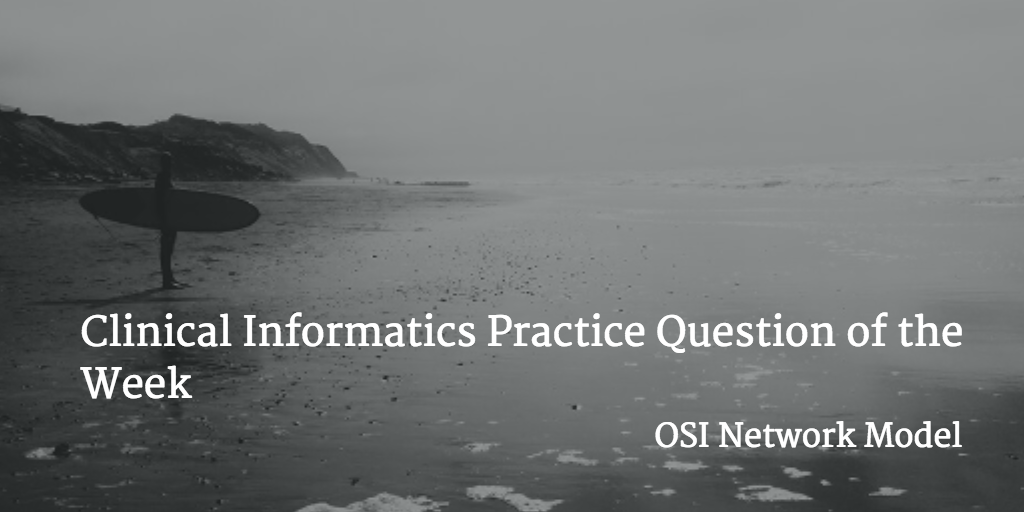Welcome to this week’s clinical informatics practice question of the week. Every Thursday, we aim to introduce a new topic to help you learn a little more to successfully pass the clinical informatics subspecialty board examination.
Last week we discussed the five rights of clinical decision support. In this week’s topic, we’ll be reviewing the OSI model.
The Open Systems Interconnection Model (OSI Model) “characterizes and standardizes the communications functions of a telecommunication or computing system without regard of their underlying internal structure and technology”. Basically – it’s a generic, brand-name, specific standards free model of all the elements required to run and operate a communications system.
There are 7 different layers.
- The physical layer
- The data link layer
- The network layer
- The transport layer
- The session layer
- The presentation layer
- The application layer
Question
Which of the following layers is responsible for structuring and managing a multi-node network via addressing, routing, and traffic control?
A. The data link layer
B. The network layer
C. The session layer
D. The application layer
Answer and Explanation
Let’s review the seven layers of the OSI model. They are:
Layer 1: Physical layer
o The electrical and physical means to stream bits across the network (cables, pins, hubs, adapters, etc.).
Layer 2: Data link layer
o The functional and procedural means to transfer data within the network. The data link layer creates and recognizes the frame boundary [Point-to-point protocol (PPP), IEEE 802.2 LLC, etc.).
Layer 3: Network layer
o The functional and procedural means to transfer data sequences between hosts on different networks. The network layer performs routing, fragmentation, reassembly, and handles delivery errors (IP, IPSec, AppleTalk, etc.).
Layer 4: Transport layer
o Transfers data between end users and ensures successful transfer of data packets (TCP, UDP, etc.).
Layer 5: Session Layer
o The user interface through which end users connect to the network (NetBIOS, SAP, Named Pipe, etc.).
Layer 6: Presentation Layer
o Provides context for the application layer using syntax and semantics (if mapping is available). The presentation layer transforms data into something applications understand (MIME, XDR, etc.).
Layer 7: Application Layer
o Where the end user interacts with the application. The application layer synchronizes communication, identifies communication partners, and determines the availability of resources (HTTP, DNS, DHCP, SMTP, etc.)
The correct answer is B. The network layer.
Further Learning
A new practice questions comes out every Thursday. Add us to your RSS reader or check back here every week.
If you’re studying for the exam and looking for more resource on clinical informatics, you can purchase our text – Clinical Informatics Board Review: Pass the Exam the First Time. It’s the only board review book for the clinical informatics exam and comes with a money back guarantee if you don’t pass the exam on your first attempt – it’s the only study material for the clinical informatics exam with one.
Out 10 practice question quiz on clinical informatics is available at learn.informaticspro.com. Check it out to see how well you’re progressing.
